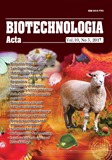SSN 2410-7751 (Print)
ISSN 2410-776X (Online)
"Biotechnologia Acta" V. 10, No 3, 2017
https://doi.org/10.15407/biotech10.03.041
Р. 41-49, Bibliography 24, English
Universal Decimal Classification: 577.112:57.083.3

POLYCLONAL ANTIBODIES AGAINST HUMAN PLASMINOGEN KRINGLE 5
Palladian Institute of Biochemistry of the National Academy of Sciences of Ukraine, Kyiv
The aim of the research was to obtain the polyclonal antibodies against a fragment of human plasminogen kringle 5 and to study their immunochemical properties. The following approaches were used: immunization of rabbits with plasminogen kringle 5, receiving of high-titer immune serum, synthesis of kringle 5-based affinity sorbent for selection of monospecific antibodies, chromatography on synthesized K 5-Sepharose, ELISA immunoblot assay.
The obtained polyclonal antibodies reacted in ELISA with a plasminogen K 5 fragment, and to a much lesser extent with mini-plasminogen, Lys-plasminogen, K 1-3 and K 4 plasminogen fragments, Glu-plasminogen, in descending order. Based on the dissociation constant determination it was found that these antibodies had high affinity to their epitopes within K 5 fragment (3.89·10–10 M), mini-plasminogen (5.46·10–9 М) and Lys-plasminogen (2.54·10–9 М), and insignificant affinity to K1-3, K4 and Glu-plasminogen. These antibodies reacted in immunoblotting assay with an isolated K 5 fragment of human plasminogen, Lys-Pg and mini-Pg, and did not react with K 5 in Glu-Pg and with K 1-3 or K 4 fragments. Thus, the obtained polyclonal antibodies were monospecific and had a high affinity to kringle 5. These antibodies can be used for the development immuno chemical and immunosensory methods for the quantitative determination of angiostatin K 5 in biological materials.
Key words: human plasminogen fragments, kringle 5, polyclonal antibodies, angiostatines.
© Palladin Institute of Biochemistry of National Academy of Sciences of Ukraine, 2017
References
1. V?radi A., Patthy L. Kringle 5 of human plasminogen carries a benzamidine-binding site. Biochem. Biophys. Res. Communic. 1981, 103 (1), 97–102.
2. Vali Z., Patthy L. Location of the Intermediate and High Affinity w-Aminocarboxylic Acidbinding Sites in Human Plasminogen. J. Biol. Chem. 1982, 257 (4), 2104–2110.
3. Thewes T., Constantine K., Byeon I.-J. L., Llinas M. Ligand Interactions with the Kringle 5 Domain of Plasminogen. J. Biol. Chem. 1990, 265 (7), 3906–3915.
4. Komisarenko S. V. Chemistry of Peptides and Proteins. (Voelter W., Bayer E., Ovchinnikov Y., Ivanov V. (Eds.)). Walter de Gruyter & Co, Berlin-N. Y. 1986, V. 3, P. 235–247.
5. Lu H. Kringle 5 causes cell cycle arrest and apoptosis of endothelial cells. Biochem. Biophys. Res. Communic. 1999, V. 258, Р. 668–673.
6. Cao Y., Chen A., An S. S., Ji R. W., Davidson D., Llin?s M. Kringle 5 of plasminogen is a novel inhibitor of endothelial cell growth. J. Biol. Chem. 1997, V. 272, Р. 22924–22928.
7. Davidson D. J., Haskell C., Majest S., Kherzai A. Kringle 5 of Human Plasminogen Induces Apoptosis of Endothelial and Tumor Cells through Surface-Expressed Glucose-Regulated Protein 78. Cancer Res. 2005, 65 (11), 4663–4672.
8. Perri S. R., Nalbantoglu J., Annabi B., Koty Z., Lejeune L., Fran?ois M., Di Falco M. R., B?liveau R., Galipeau J. Plasminogen Kringle 5–Engineered Glioma Cells Block Migration of Tumor-Associated Macrophages and Suppress Tumor Vascularization and Progression. Cancer Res. 2005, 65 (18), 8359–8365.
9. Gao G., Li Y., Gee S., Dudley A., Fant J., Crosson C., Ma J.-X. Down-regulation of Vascular Endothelial Growth Factor and Up-regulation of Pigment Epithelium-derived Factor. A possible mechanism for the anti-angiogenic activity of plasminogen kringle 5. J. Biol. Chem. 2002, 277 (11) 9492–9497.
10. Ma J., Li Ch., Shao Ch., Gao G., Yang X. Decreased K5 receptor expression in the retina, a potential pathogenic mechanism for diabetic retinopathy. Mol. vision. 2012, V. 18, Р. 330–336.
11. Zhang D., Kaufman P. L., Gao G., Saunders R. A., Ma J. X. Intravitreal injection of plasmino gen kringle 5, an endogenous angiogenic inhibitor, arrests retinal neovascularization in rats. Diabetologia. 2001, V. 44, Р. 757–765.
12. Deutsch D. G., Mertz E. T. Plasminogen: purification from human plasma by affinity chromatography. Science. 1970, 170 (3962), 1095–1096.
13. Kapustianenko L. G., Iatsenko T. A., Yusova E. I., Grinenko T. V. Isolation and purification of a kringle 5 from human plasminogen using AH-Sepharose. Biotechnol. acta. 2014, 7 (4), 35–42. https://doi.org/10.15407/biotech7.04.035
14. March S. A simplified method for cyanogen bromide activation of agarose for affinity chromatography. Anal. Biochem. 1974, 60 (1), 149–152.
15. Robbins K. C., Summaria L. Plasminogen and plasmin. Meth. Enzymol. 1976, V. 45, P. 257–273.
16. Sottrup-Jensen L., Claeys H., Zajdel M., Petersen T. E., Magnusson S. The primary structure of human plasminogen: isolation of two lysine-binding fragments and one “Mini”-plasminogen (M.W.38.000) by elastasecatalyzed-specific limited proteolysis. Progress in Chemical Fibrinolysis and Thrombolysis. (Davidson J. F., Rowan R. M., Samama M. M., Desnoyers P. C. (Eds.)). New York: Raven Press. 1978, Р. 191–209.
17. Demchenko A. P. UV spectrophotometry and the proteins structure. Kiev: Naukova dumka. 1981, 208 p. (In Russian).
18. Harlow E., Lane D. P. Antibodies: A Laboratory Manual. New York: CSHL Press. 1988, 726 p.
19. Zapadnjuk I. P. Breeding, keeping, use in experiment. Kyiv: Vyshcha Shkola. 1974, P. 148–174. (In Russian).
20. Panyim S., Chalkley R. High resolution acrylamide gel electrophoresis of histones. Arch. Biochem. Biophys. 1969, 130 (1), 337–346.
21. Sch?gger H., Von Jagow G. Tricinesodium dodecyl sulfate-polyacrylamide gel electrophoresis for the separation of proteins in the range from 1 to 100 kDa. Anal. Biochem. 1987, V. 166, Р. 368–379.
22. Tsang V. C. W. Enzyme-linked immunoelectrotransfer blot techniques (EITB) for studying the specificities of antigens and antibodies separated by gel electrophoresis. Methods Enzymol. 1983, V. 92, P. 377–391.
23. Bobrovnik S. A. Determination of antibody affinity by ELISA. Theory. J. Biochem. Biophys. Methods. 2003, V. 57, Р. 213–236.
24. Grinenko T. V., Kapustianenko L. G., Yatsenko T. A., Yusova O. I., Rybachuk V. N. Plasminogen fragments K 1-3 and K 5 bind to different sites in fibrin fragment DD. Ukr. Biochem. J. 2016, 88 (3), 36–45.

